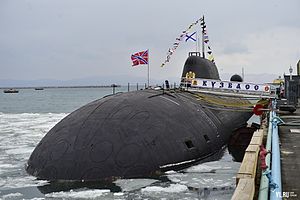 Akula-class SSN profile
| |

| |
| Class overview | |
|---|---|
| Name | Akula class |
| Builders | |
| Operators | |
| Preceded by | Victor class, Sierra class |
| Succeeded by | Yasen class |
| Cost | est. $1.55 billion (1995 dollars) |
| Built | 1983–1999 |
| In commission | 1984–present |
| Planned | 20 |
| Completed | 15 |
| Cancelled | 4 (1 Iribis suspended 42% complete since 1996) |
| Active | 4 (4 active +6 on modernization in Russia) |
| Retired | 4 |
| General characteristics | |
| Type | Nuclear attack submarine |
| Displacement |
|
| Length |
|
| Beam | 13.6 m (45 ft) |
| Draught | 9.7 m (32 ft) |
| Propulsion |
|
| Speed |
|
| Endurance | 100 days[3] |
| Test depth |
|
| Complement | 73 for Akula I & Improved,[5] 62 (31 officers) for Akula II & III.[6] |
| Sensors and processing systems |
|
| Electronic warfare & decoys | |
| Armament | |
| Notes | |
The Akula class, Soviet designation Project 971 Shchuka-B (Russian: Щука-Б, lit. 'Pike-B', NATO reporting name Akula) is a series of fourth generation nuclear-powered attack submarines (SSNs) first deployed by the Soviet Navy in 1986. There are four sub-classes or flights of Shchuka-B, consisting of the original seven Project 971 boats (codenamed Akula I), commissioned between 1984 and 1990; six Project 971Is (Improved Akulas), commissioned between 1991 and 2009; one Project 971U (Akula II), commissioned in 1995; and one Project 971M (Akula III), commissioned in 2001. The Russians call all of the submarines Shchuka-B, regardless of modifications.[7]
Some confusion may exist as the name Akula (Russian: Акула, meaning "shark" in Russian) was used by the Soviets for a different class of submarines, the Project 941, which is known in the West as the Typhoon class. The Project 971 was named Shchuka-B by the Soviets but given the designation Akula by the West after the name of the lead ship, K-284.
According to defense analyst Norman Polmar, the launch of the first submarine in 1985, "shook everyone [in the West] up", as Western intelligence agencies had not expected the Soviet Union to produce such a boat for another ten years.[8]
- ^ "Russian submarines" (PDF). lynceans.org. October 2018. Retrieved 18 April 2023.
- ^ Saunders, Stephen, ed. (2008). Jane's Fighting Ships 2008-09. Coulsdon, UK: Jane's Information Group. p. 644. ISBN 978-0-71062-845-9.
- ^ Cite error: The named reference
Podvodnye Lodki 2003was invoked but never defined (see the help page). - ^ "The Ship Day to be celebrated at SSN Kuzbass". Rusnavy.com. 28 January 2010. Archived from the original on 17 September 2012. Retrieved 4 October 2012.
- ^ "Specification: SSN Akula Class (Bars Type 971) Attack Submarine, Russia". Naval-technology.com. Archived from the original on 5 June 2011.
- ^ "Typhoon (Akula) class (Project 941/941U) (Russian Federation)". Jane's Fighting Ships. 24 July 2012. Archived from the original on 26 January 2013. Retrieved 4 October 2012.
- ^ "In-service ships". Rusnavy.com. Archived from the original on 5 October 2012. Retrieved 4 October 2012.
- ^ Norman, Colin (31 March 1989). "Quiet Soviet Subs Prompt Concern". Science. 243 (4899). American Association for the Advancement of Science: 1653–1654. Bibcode:1989Sci...243.1653N. doi:10.1126/science.243.4899.1653. JSTOR 1703462. PMID 17751269.